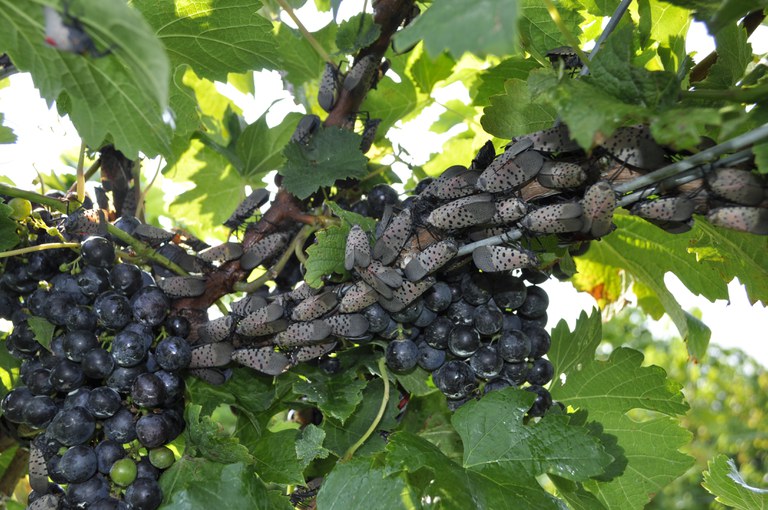Posted: December 4, 2018
Research and awareness around the Spotted Lanternfly (SLF) continues to increase as proposals are selected for funding to help fight this invasive species. These sap-feeding insects are a major threat to U.S. agriculture, timber industry, and many managed and natural ecosystems, feeding on over 70 species of plants.

Lycorma delicatula, commonly known as the Spotted Lanternfly (SLF), invading a grapevine. IMAGE: ERICA SMYERS, PENN STATE
UNIVERSITY PARK, Pa. - Research and awareness around the Spotted Lanternfly (SLF) continues to increase as proposals are selected for funding to help fight this invasive species. These sap-feeding insects are a major threat to U.S. agriculture, timber industry, and many managed and natural ecosystems, feeding on over 70 species of plants.
Faculty in the College of Agricultural Sciences, Julie Urban (PI, Entomology), Sampurna Sattar (Co-PI, Plant Science), Michela Centinari (Co-PI, Plant Science) and Cristina Rosa (Co-PI, Plant Pathology and Environmental Microbiology) have been selected for funding as part of the college's 2018 Strategic Networks and Initiatives Program (SNIP) Level I Launch Grant. Their proposal entitled, "Establishment of a readiness program to evaluate the potential threat posed by invasive sap-feeding insects to managed and natural ecosystems," will focus its efforts on the development of a novel monitoring system for evaluating SLF impacts on plants. The system will simultaneously monitor feeding behavior and plant responses to the SLF.
"In exploiting many plant species across multiple ecosystems, SLF provides a unique opportunity to explore the extent to which our monitoring approach may be applicable to other invasive sap-feeding insects and diverse plants and habitats they feed upon," said Rosa.
Proposed activities include holding a workshop, open to the Penn State community, that brings together national and international experts who have studied invasive sap-feeding insects across a variety of habitats, as well as those who have used the advanced plant monitoring technologies currently available.
"In this workshop, we will refine the potential utility of our approach, by developing protocols for use of these advanced monitoring technologies with SLF and grapevines," said Urban. "Gaining the insight of experts in use of these tools is of critical importance that nobody yet knows how to adapt Electrical penetration Graphs (EPG) recording to an insect as large as SLF (as it has been used on aphids and other similarly small insects); and similarly, plant physiological monitoring techniques have typically been used on larger forest trees, and therefore must be adapted for use on grapevines."
Urban, Sattar, Centinari and Rosa plan to invoke the expertise of invited guests to identify a list of challenges to be faced and discuss potential solutions or alternative approaches for monitoring SLF feeding upon additional plant species across agricultural, forest and urban settings. This will also aid in extending their approach into a broader, predictive monitoring system applicable to other insects. By improving the prediction of plant damage and pathogen transmission that new invasive sap-feeding insects may cause in particular habitats, they may facilitate more rapid and efficient management techniques, advancing the College's cross-cutting theme of promoting environmental resilience.

